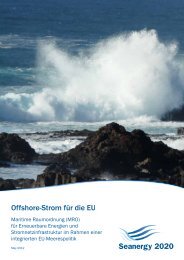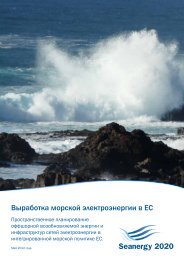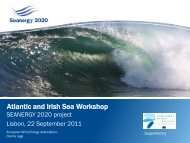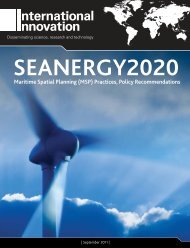Comparative analysis of Maritime Spatial Planning ... - Seanergy 2020
Comparative analysis of Maritime Spatial Planning ... - Seanergy 2020
Comparative analysis of Maritime Spatial Planning ... - Seanergy 2020
You also want an ePaper? Increase the reach of your titles
YUMPU automatically turns print PDFs into web optimized ePapers that Google loves.
5 CONSULTATION5.1 Why is consultation important to <strong>Maritime</strong> <strong>Spatial</strong> <strong>Planning</strong> (MSP)?Cooperation amongst stakeholders is important to minimise conflicts within MSP. Although stakeholderinvolvement can be more time consuming initially, participatory planning can lead to savings in the longterm. The Plancoast Handbook on Integrated <strong>Maritime</strong> <strong>Spatial</strong> <strong>Planning</strong> (Plancoast, 2008) outlines threemajor advantages:The added-value <strong>of</strong> stakeholder knowledge;Cost and time efficiency by avoiding possibly disputes and legal challenges;Improved publicity and policy acceptance – the success in implementing MSP is largely dependenton stakeholders‟ willingness to cooperate.The experience <strong>of</strong> BaltCoast also found that individual stakeholder groups are more inclined to acceptnecessary restrictions if they are involved from the outset in the planning process. In cases whereindividual interest groups felt left out they stuck positions <strong>of</strong> maximum demands making a reconciliation <strong>of</strong>interests impossible. A wide and open discussion, however, led to a better understanding <strong>of</strong> necessaryrestrictions (BaltCoast, 2005).In the EU Guidelines for an Integrated Approach to <strong>Maritime</strong> Policy (COM, 2008b), there is significantemphasis placed on promoting effective stakeholder consultation:Member States developing their own national integrated maritime policies are recommended to promoteand facilitate appropriate stakeholder structures, allowing broad participation by stakeholders ingovernance <strong>of</strong> maritime affairs, taking measures to increase the capacity <strong>of</strong> the social partners andensuring a transparent decision-making process.5.2 Progress per sea basinIn terms <strong>of</strong> consultation many <strong>of</strong> the North Sea countries have made significant progress on consultationwithin MSP. Where there are maritime spatial plans in places such as in Belgium and Germany, significantpublic and sector consultation on these plans took place before they were approved. For example Germanyundertook a 3-month public consultation period before development <strong>of</strong> the draft MSP and ongoingconsultations for a year before the MSP was finalised. Belgium had a six month period <strong>of</strong> stakeholdermeetings and interviews before development <strong>of</strong> the Master Plan for the North Sea. All North Sea countries(Germany, Belgium, The Netherlands, Denmark and the UK) have effectively translated the EIA Directiveinto national legislation and this allows for public consultation. In most countries information is madepublically available and details are given on how the consultation processed influenced the final decision.Deliverable 2.329 | P a g e






